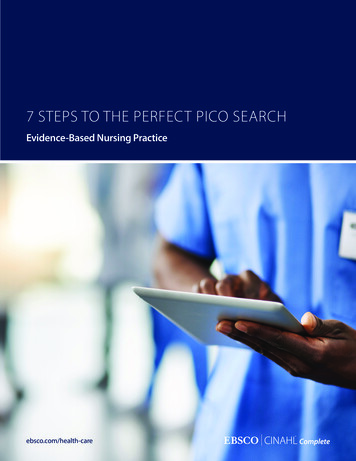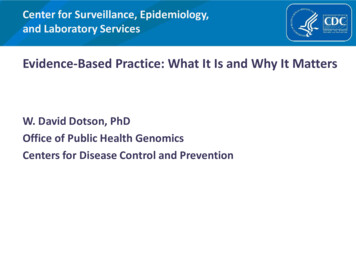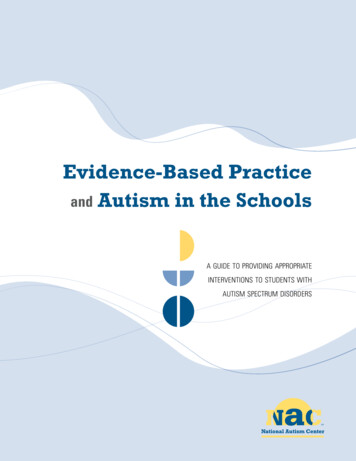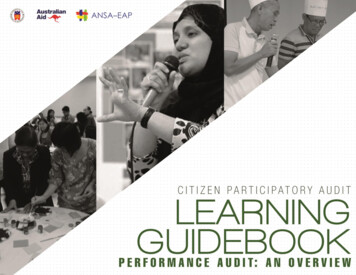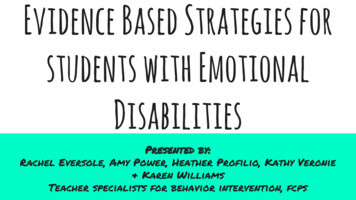
Transcription
Evidence Based Strategies forstudents with EmotionalDisabilitiesPresented by:Rachel Eversole, Amy Power, Heather Profilio, Kathy Veronie& Karen WilliamsTeacher specialists for behavior intervention, fcps
Learning Objectives:1.Refresh your understanding of the “Science of Behavior”.2.Review classroom strategies that support all students.3. Discuss, define, and determine how to use self-regulationstrategies with students with Emotional Disabilities.4. Remind ourselves to be aware of our own reactions to thechallenging behavior of students and the importance of having a plan.
.t.ituobaWhat is the most persistent and difficult behavior in your rooM?etirWWho is the student?What do you know about the student (personally, educationally,etc)?What does the student do that impacts you, instruction, or otherstudents?What interventions are in place?
Keep in mind Behaviors are Functional and CommunicativeBoth desirable and undesirable behaviors have a purpose or functionBehavior problems are likely a result of skill deficitsBehaviors in context Behavior change takes time and requires feedback, modeled examples ofdesired behavior and reinforcement. Interventions are most effective when implemented early-on and withconsistency.This is the Science of Behavior
What is an Emotional Disability?IDEA Definition: a condition exhibiting one or more of the following characteristics over a long period of timeand to a marked degree that adversely affects a child’s educational performance:(A) An inability to learn that cannot be explained by intellectual, sensory, or health factors.(B) An inability to build or maintain satisfactory interpersonal relationships with peers andteachers.(C) Inappropriate types of behavior or feelings under normal circumstances.(D) A general pervasive mood of unhappiness or depression.(E) A tendency to develop physical symptoms or fears associated with personal or schoolproblems.”
In order to be eligible for services under IDEA, the student, by reason of theirdisability, must require special education and related services. The definition of Emotional Disability is not a diagnosis or medical term, butrather a term used in the federal education law to designate eligibility for specialeducation. Under IDEA, if a child is found eligible, the student is guaranteed anIndividualized Educational Plan (IEP) that is designed to meet their unique needs.As defined by IDEA, emotional disability includes schizophrenia but does NOTapply to children who are socially maladjusted, unless it is determined that theyhave an emotional disturbance.[Code of Federal Regulations, Title 34 C.F.R., Section 300.8(c)(4)] [Code of Maryland AnnotatedRegulations, Section 13A.05.01.03]Williams20146
What is Social Maladjustment? Though not defined by Federal regulations, in order to make adiagnosis of social maladjustment, professionals consult the criteriafor conduct disorder and oppositional defiant disorder from theDSM. Typical symptoms include: a persistent pattern of willful refusal to meet even minimumstandards of conduct. behavior and values often in conflict with society’s standards. a consistent pattern of antisocial behavior without genuine signsof guilt, remorse, or concern for the feelings of others. Behaviors typically occur in response to consequences. (ex: told no,loss of privileges).
TYpes most commonly seen in schools Mood Disorders Anxiety Disorders Bipolar, Depression, DMDDGAD, OCD, PTSDPsychotic Disorders Schizophrenia, Schizoaffective
Where does an emotional Disability come from?Physiological factors Genetic historyBrain chemistry (clinical diagnosis of any number of disorders)Environmental Factors Neglect Malnutrition, personal care, hygiene, lack in parenting skillsTrauma- (i.e. physical, emotional, sexual abuse)Life circumstances
Impact on a student’s daily life An emotional disability is a condition that may disrupt a person's ability torelate to others, while impacting their feelings, mood, and daily functioning. Children with an emotional disability may exhibit distorted thinking, excessiveanxiety, or abnormal mood swings. (i.e. self-regulation) Disability interferes with student’s ability to function in an educationalprogram using traditional instructional materials and techniques.https://www.youtube.com/watch?v CN Zfgxg0Aw
What can Emotional Disability look like?Externalizing BehaviorsInternalizing BehaviorsVerbal/physical aggressionAnxious behaviorsHyperactivityWithdrawalPsycho-motor movementsDepressed behaviorsRule-breaking behaviorInattentionOppositional behaviorPerfectionistic tendenciesSudden mood changesShutting down/unresponsiveUnder-reactive behaviors
6 Evidence based strategiesto support All students
EVidence Based Classroom Management Strategies:1.Establish routines early and maximize structure in your classroom.2.Establish a relationship with your students (i.e. Greet them everyday, learn aboutwho they are)3.Post, teach, review, monitor, and reinforce a small number of positively statedexpectations (rules).4.Actively engage students in observable ways and make sure to decrease down time.5.Establish a continuum of strategies to acknowledge appropriate behavior andprovide positive praise and reinforcement EVERYDAY (5:1 ratio).6.Establish a continuum of strategies to respond to inappropriate behavior.
Whose Problem is it? http://www.youtube.com/watch?feature player embedded&v eRijTGgOvlY
When responding to inappropriate behavior: Remain calm and be aware of your bodylanguage when addressing behavior Enforce the rules with predictability in acalm and confident manner Even when a student is in crisis alwaysrespond with respect and unconditionalpositive regard Use redirection with activities,conversation or location when achallenging behavior is beginning tooccur. Show displeasure with behaviors NOTthe student. Refer to established visual or verbal cues asreminders for inappropriate behaviors. Reinforce the opposite behavior when it isobservable in other students( “I’m looking for students who are ”. “ Isee who is listening”.) Use proximity control. Be aware of yourphysical location ( in the room, in relation tothe student) Deliver unhappy feedback quietly and movequickly and calmly to control misconduct.
Self RegulationWhat do studentswith an EmotionalDisability need?PhysicalEmotionalCognitive
What is physical regulation?When the physical response is triggered: The Lower brain is engagedBody is ready for actionPerformance requiring thought is compromised Problem SolvingLearningWhat types of behaviors may be observed?
ActivityHow does physical regulation relate to? Relationships (peer or student-teacher)Academic engagementWork completionAccess to the school environment
Physical regulationLearning Goals Physical signs and symptoms (i.e. warning signs, “the alarm”) Calming techniquesOutcome Learn to Moderate the Fight/Flight/Freeze Response Restore to body baselineStrategies Include Patterned/Rhythmic movements Stretching Breathing & relaxation Create Predictability Distraction
Physical Strategies Recognize physical signs and interrupt itDrill like safety drillsExamples: My warning signsAnimal stretchesMelting freezeSafe placeQi Gong, Yoga, Tai Chi https://www.youtube.com/watch?v uMctuDEvCOY
What is emotion regulation?Emotional regulation is a term used to describe a person’s ability to effectivelymanage and respond to an emotional experience. People unconsciously useregulation strategies to cope with difficult situations. (Ex. talking with friends,therapy, taking a break, exercising, meditating)When an emotional response is triggered in students that have poor regulation,often times the strategies they use to attempt to regulate are unhealthy. Self-InjuryPhysical AggressionVerbal AggressionAvoidance or withdrawing
ActivityHow does emotional regulation relate to ? Relationships (peer or student-teacher)Academic engagementWork completionAccess to the school environment
Emotional regulationLearning Goals Identify and label feelings Developing expressive outlets Ownership and control of emotionsOutcome Accurately identify emotional states in self and others Accept responsibility for feelings Express feelings in healthy and appropriate waysStrategies Feelings Playlist Emotional SafeThis video would be helpful in teaching students to pair Emotional Bingofacial expressions with emotions, as well as, labeling. Emotion Charadeshttps://www.youtube.com/watch?v UjZzdo2-LKE
Emotional Strategies Reflect the feelings you see and provide a language of emotions. Talk about emotional experiences and support accurate labeling offeelings. Anticipate and plan for self-regulation by providing a healthy outletfor expression. Listen without judgement and teach ownership of feelings. (You can’tmake me laugh) Praise successful self-regulation. MirroringVideos like this one could be a great introduction to helping students identify a difficult feeling likeembarrassment. https://www.youtube.com/watch?feature player embedded&v Yr1wc4khkGM
What is Cognitive regulation?The goals of cognitive regulation are: Problem-solving Planning and organization Insight and understanding Forming healthy beliefs about ourselves and the world around usWhen a cognitive response is triggered you may hear things such as: “I can’t control myself.” “It’s just my Bi-Polar.” Rigid, inflexible thinking.
activityHow does Cognitive Regulation relate to: Relationships (peer or student-teacher)Academic engagementWork completionAccess to the school environment
Cognitive regulationLearning Goals Develop insight into motives for behavior (function) Plan and organize reinforcement schedule Healthy vs. Unhealthy thinking Healthy beliefs about ourselves and the worldOutcome Increase Problem Solving Skills Develop Planning and Organization Skills Gain insight and understanding Enhance Goal directed behaviorsStrategies Specific training to problem areas Learning about patterns of behaviors Healthy vs. unhealthy thinking
Cognitive Strategies Organizational ToolsTeach a concrete problem solving modelConsequence Mapping/Decision Making VisualUse of daily schedules or task checklistsUse of a timerPlanning specific thoughtsVisualizing a desired outcomesPositive self talk
Problem SolvingTeaching the problem-solving process tochildrenChildren who are old enough to think abstractly(from around 12) can be taught the problemsolving process directly, using real-lifeexamples and 'live applications' to illustrate theprocess.Younger children will learn best by having theprocess demonstrated repeatedly by adults tohelp them solve their day-to-day social andother problems.
Refer back to thestudent youidentified earlierReflect on and discuss how you will supportthe student, keeping in mind the Six EvidenceBased Strategies, and Self-Regulation.
ConclusionPhysical Learn Warning Signs Get Safe Calming strategyEmotional Label Own Express healthilyCognitive Identify and Challenge unhealthy thinking Plan to change unhealthy patterns Learn problem solving steps
Feedback surveyBy the end of the week, you will receive an emailcontaining a link to a survey on thisprofessional learning session. Please take a fewminutes to fill it out and let us know how youfelt about the training.Thank you!Sincerely,The Behavior Intervention and Supports Team
REFERENCESChapin, B. (n.d.). Self-Regulation: Teaching Impulse Control & Skills for Success.AccuTrain.Lipsett, A. (2011, Fall). Supporting Emotional Regulation in Elementary School:Strategies and Classroom Interventions to Promote Self-Regulation. LEARNingLandscapes, 5(1), 157-175. Retrieved November 1, 2016, nts/ll-no9/ablipsett.pdfRolston, A., & Lloyd-Richardson, E., Ph.D. (n.d.). What is emotion regulation andhow do we do it? 1-5. Retrieved November 1, 2016, esources/what-is-emotion-regulationsinfo-brief.pdf
1) Establish routines early and maximize structure Build predictability within the daily routinewhen possible; “prime” students ahead oftime for changes in routine and/orexpectations.Apply county, school and classroom rulesfairly, consistently and immediatelyRefer to established classroom rules andconsequences, de-personalize the problem.Be familiar with individual behavior plansand contracts and be prepared toimplement themUse specific praise-feedback; address thework not the person When verbally addressing challengingbehavior state specifically what the studentshould be doingProvide an adequate level of support andsupervision across all settingsUnderstand the cycle of a behavior crisisWhen possible provide student with astructured, pre-planned way out of anescalating situation.If at all possible, avoid confronting students infront of a group. A private conversationcommunicates respect and helps to avoidembarrassment to prevent a power struggle.Avoid power struggles, they are notproductive and they undermine your ability toset limits and gain compliance.
2) Establish a relationship with your studentsHow? Show your pleasure and enjoyment of students. Greet them by name each day at the door or in the hallway. Interact with students in a responsive and respectful manner. Offer students help (e.g., answering questions in timely manner, offering support that matchesstudents' needs) in achieving academic and social objectives. Help students reflect on their thinking and learning skills. Know and demonstrate knowledge about individual students' backgrounds, interests, emotionalstrengths and academic levels. Avoid showing irritability or aggravation toward students- QTIPP Acknowledge the importance of peers in schools by encouraging students to be caring andrespectful to one another. Model a professional and respectful atmosphere
3) Post, Teach, Review, Monitor, and ReinforceExpectations Actively teach students socially and behaviorallyappropriate skills while providing opportunitiesfor the students to exhibit the appropriatebehaviors. Identified expectations are posted andare explicitly and systematically taught andreinforced.
4) Actively Engage Students in Observable Ways Utilizing a variety strategies occurring on acontinuum ranging from least to mostrestrictive in response to the inappropriatebehavior is related to increased studentproductivity and improved student self-control.
5) Use a continuum of strategies to acknowledgeappropriate behavior Utilizing a variety strategies occurring on acontinuum ranging from the least to the mostintensive in order to acknowledge appropriatebehavior are related to increased studentproductivity and improved student self-control.
6) Use a Continuum of Strategies to Respond toInappropriate Behavior Utilizing a variety strategies occurring on acontinuum ranging from least to most restrictivein response to the inappropriate behavior isrelated to increased student productivity andimproved student self-control.
regulation strategies to cope with difficult situations. (Ex. talking with friends, therapy, taking a break, exercising, meditating) When an emotional response is triggered in students that have poor regulation, often times the strategies they use to attempt to regulate are unh




